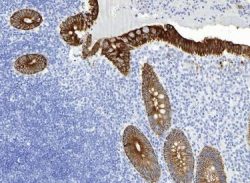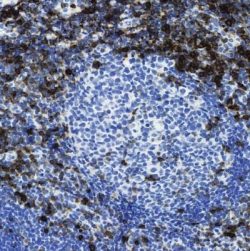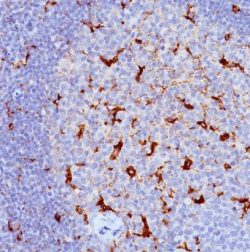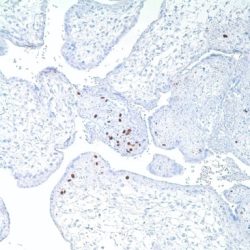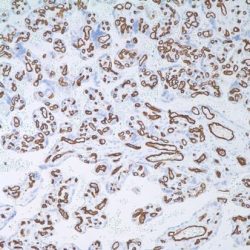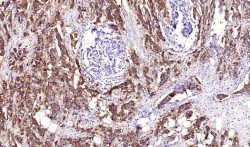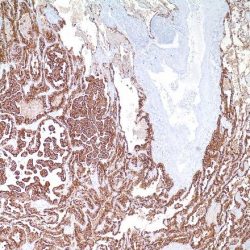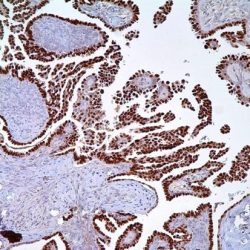Archives: فروشگاه
نمایش 641–651 از 651 نتیجه
فیلتر ها-
آنتی بادیهای ایمونوهیستوشیمی
آنتی بادی Cytokeratin Cocktail کلون AE1+AE3+C11+DC10 برند Patho Sage
نمره 0 از 5Specification:
Twenty human keratins are resolved with two-dimensional gel electrophoresis into acidic (pI <5.7) and basic (pI >6.0) subfamilies. This antibody cocktail recognizes acidic (Type I or LMW) and basic (Type II or HMW) cytokeratin’s, with 67kDa (CK1); 64kDa (CK3); 59kDa (CK4); 58kDa (CK5); 56kDa (CK6); 55kDa (CK7); 52kDa (CK8); 56.5kDa (CK10); 53kDa (CK13); 50kDa (CK14); 50kDa (CK15); 48kDa (CK16); 46kDa (CK17); 45kDa (CK18) and 40kDa (CK19). Many studies have shown the usefulness of keratins as markers in cancer research and tumor diagnosis. KRT-PAN is a broad-spectrum anti pan cytokeratin antibody cocktail, which differentiates epithelial tumors from non-epithelial tumors e.g. squamous vs. adenocarcinoma of the lung, liver carcinoma, breast cancer, and esophageal cancer. It is useful in characterizing the source of various neoplasms and to study the distribution of cytokeratin containing cells in epithelia during normal development and during the development of epithelial neoplasms. This antibody stains cytokeratin’s present in normal and abnormal human tissues and shows high sensitivity in the recognition of epithelial cells and carcinomas.
Immunogen:
Human epidermal keratin
Presentation:
Bioreactor Concentrate with 0.05% Azide
-
آنتی بادیهای ایمونوهیستوشیمی
آنتی بادی Lambda Immunoglobulin Light Chain کلون LAMB14 برند Patho Sage
نمره 0 از 5Specification:
Anti-Lambda detects surface immunoglobulin on normal and neoplastic B-cells. Lambda staining is seen in B-cell follicles of human lymphoid tissue. When dealing with B-cell neoplasms, the determination of light chain ratios remains the centerpiece. This is sound reasoning because most B-cell lymphomas express either kappa or lambda light chains, whereas reactive proliferations display a mixture of kappa and lambda positive cells. If only a single light chain type is detected, a lymphoproliferative disorder is very likely. Monoclonality is determined by a kappa-lambda ratio of greater than or equal to 3:1, a lambda-kappa ratio greater than or equal to 2:1 or a monoclonal population of 75% or more of the total population.
Presentation:
Anti-Lambda is a mouse monoclonal antibody from supernatant diluted in tris buffered saline, pH 7.3-7.7, with protein base, and preserved with sodium azide.
-
آنتی بادیهای ایمونوهیستوشیمی
آنتی بادی P63 کلون 4A4 برند Patho Sage
نمره 0 از 5Specification:
The p63 gene is located at chromosome 3q27-29 and belongs to the p53 gene family. p63 plays a critical role in the growth and development of many epithelial organs. p63 is confined to basal cells of squamous epithelia (including epidermis and hair follicles) and urothelium, as well as basal cells/myoepithelial cells in breast, sweat glands, salivary glands, and prostate. The expression of p63 has clinical value as a diagnostic marker in various tumor types. Thus, p63 helps to distinguish squamous cell carcinoma from adenocarcinoma in the lung or urothelial carcinoma from renal cell carcinoma. As known marker of basal cells in breast and prostate, p63 expression is useful for prostate cancer diagnosis and identifies a basal phenotype in some breast carcinomas.
Presentation:
tissue culture supernatant with 15mM sodium azide
-
آنتی بادیهای ایمونوهیستوشیمی
آنتی بادی CD5 کلون C5/473 برند Patho Sage
نمره 0 از 5Specification:
Recognizes a 67kDa transmembrane protein, which is identified as CD5. The CD5 antigen is found on 95% of thymocytes and 72% of peripheral blood lymphocytes. In lymph nodes, the main reactivity is observed in T cell areas. CD5 is expressed by many T cell leukemia, lymphomas, and activated T cells. Occasionally, CD5 antigen is also expressed on a subset of B cells. Mantle cell lymphomas (same as diffuse centrocyte lymphomas) are CD5+ while the follicle center cell lymphoma is CD5-negative. This MAb is superb for identifying the formalin-fixed, paraffin-embedded mantle cell lymphomas.
Immunogen:
Human CD5 recombinant protein
Presentation:
Bioreactor Concentrate with 0.05% azide
-
آنتی بادیهای ایمونوهیستوشیمی
آنتی بادی KI67 کلون MIB1 برند Patho Sage
نمره 0 از 5Specification:
The Ki-67 protein is a nuclear protein doublet, 345-395 kDa, playing a pivotal role in maintaining cell proliferation. In diagnostic histopathology and cell biology, the antibody has proven valuable for the demonstration of the Ki-67 antigen in normal and neoplastic cells, for example in soft-tissue sarcoma, prostatic adenocarcinoma, and breast carcinoma. The Ki-67 has been confirmed as a very powerful single prognostic factor for overall survival, with highly proliferative cases showing a much poorer outcome than tumors with low proliferation. In breast cancer, the proliferative index measured by Ki-67 immunoreactivity has both prognostic and predictive value.
Presentation:
Tissue culture supernatant containing 15mM sodium azide
-
آنتی بادیهای ایمونوهیستوشیمی
آنتی بادی CD68 کلون KP1 برند Patho Sage
نمره 0 از 5Specification:
This antibody recognizes a glycoprotein of 110kDa, which is identified as CD68. This MAb is important for identifying macrophages in tissue sections. It stains macrophages in a wide variety of human tissues, including Kupffer cells and macrophages in the red pulp of the spleen, in lamina propria of the gut, in lung alveoli, and in bone marrow. It reacts with myeloid precursors and peripheral blood granulocytes. It also reacts with plasmacytoid T cells, which are supposed to be of monocyte/macrophage origin. It shows strong granular cytoplasmic staining of chronic and acute myeloid leukemia and also reacts with rare cases of true histiocytic neoplasia. Tumors of lymphoid origin are usually not stained.
Immunogen:
Subcellular fraction of human alveolar macrophages
Presentation:
Bioreactor Concentrate with 0.05% Azide
-
آنتی بادیهای ایمونوهیستوشیمی
آنتی بادی CMV (Cytomegalovirus) پلی کلونال برند Patho Sage
نمره 0 از 5Specification:
Human cytomegalovirus (CMV) is a β-herpesvirus (human herpesvirus 5) that causes widespread persistent infection. CMV continues to be an important opportunistic pathogen in immunocompromised patients. It is estimated that 30% of transplant recipients experience CMV disease.1 The range of organ involvement in post-transplant CMV disease is wide; hepatitis occurs in 40% of liver transplant recipients2, and pneumonitis is more frequently seen in heart and heart-lung transplant patients.3 Other organs that are commonly affected are the gastrointestinal tract and the peripheral and central nervous systems. Histologic diagnosis of CMV in fixed tissues usually rests on identifying characteristic cytopathic effects including intranuclear inclusions, cytoplasmic inclusions, or both, especially in the endothelial cells. However, histologic examination lacks sensitivity, and in some cases atypical cytopathic features can be confused with reactive or degenerative changes.4 Additionally, up to 38% of patients with gastrointestinal CMV disease fail to demonstrate any inclusions.5 In these cases, IHC using monoclonal antibodies against early and late CMV antigens allows the detection of CMV antigens in the nucleus and cytoplasm of infected cells. In addition, IHC may allow detection of CMV antigens early in the course of the disease when cytopathic changes have not yet developed.6 Various CMV antigens can serve as IHC targets for the detection of CMV infection. During productive, lytic CMV infection, the viral genes, encoding these antigens, are expressed in a coordinated and temporal fashion. The first viral genes expressed at 3-12 hours post-infection are the immediate early (IE) genes, which control viral and cellular gene expression to optimize the host environment for the production of viral DNA.7 IE gene expression is followed by viral early (E) gene transcription, or delayed early or intermediate early genes, usually expressed at 12-24 hours post infection. The E genes encode for proteins that are involved in viral DNA replication. Finally, E gene expression is followed by the transcription of viral late genes. The late genes encode for virus structural proteins.7 The sensitivity of IHC for detecting CMV infection ranges from 78% to 93%.4-5 The sensitivity of IHC is better than light microscopic identification of viral inclusions and compares favorably with culture and in situ hybridization.6-9 Additionally, immunohistochemical assays can be completed faster than the shell vial culture technique, allowing for rapid results that are important for early anti-CMV therapy.10 Immunohistochemistry has been used to detect CMV infection in patients with steroid refractory ulcerative colitis, and the routine use of IHC for the detection of CMV in the evaluation of these patients is now recommended.11-12 CMV immunostaining has been used to detect occult CMV infection of the central nervous system in liver transplant patients who develop neurologic complications.13 It has also been used to demonstrate a high frequency of CMV antigens in tissues from first trimester abortions.14
Presentation:
The product is formulated in a phosphate saline buffer (0.01M, pH 7.2) containing 0.1% sodium azide preservative
-
آنتی بادیهای ایمونوهیستوشیمی
آنتی بادی CD34 کلون QB-End/10 برند Patho Sage
نمره 0 از 5Specification:
CD34 monoclonal antibody recognizes a cell surface antigen of approximately 110Kd that is expressed selectively on human hematopoietic progenitor cells, including myeloid and lymphoid lineage progenitors, and a significant portion of acute leukemia. In addition to this stem cell recognition, this marker is expressed by vascular endothelium. Additionally, it appears that proliferating endothelial cells express this molecule in greater amounts than non-proliferating endothelial cells.
Immunogen:
Detergent solubilized vesicular suspension prepared from human term placenta
Presentation:
Bioreactor Concentrate with 0.05% Azide
-
آنتی بادیهای ایمونوهیستوشیمی
آنتی بادی C-erbB-2 (HER2) کلون ERBB2/4439 برند Patho Sage
نمره 0 از 5Specification:
Recognizes a protein of 185kDa, which is identified as c-erbB-2/HER-2/neu. Its epitope is localized in the extracellular domain. C-erbB-2/HER-2 is a member of the EGFR family. This MAb is specific and shows minimal cross-reaction with other members of the EGFR-family. Receptors of this family are located on the plasma membrane and consist of an extracellular ligand-binding domain that is connected to a large intracellular domain by a single transmembrane sequence. c-erbB 2/HER-2 protein is over-expressed in a variety of carcinomas especially those of breast and ovary.
Presentation:
Bioreactor Concentrate with 0.05% Azide
-
آنتی بادیهای ایمونوهیستوشیمی
آنتی بادی Cytokeratin 7 کلون OVTL 12/30 برند Patho Sage
نمره 0 از 5Specification:
This antibody recognizes an intermediate filament protein (IFP) of 55kDa, which is identified as cytokeratin 7. This MAb is highly specific to cytokeratin 7 and shows no cross-reaction with other IFPs. Cytokeratin 7 is a basic cytokeratin, which is found in most glandular and transitional epithelia but not in the stratified squamous epithelia. Keratin 7 is expressed in the epithelial cells of ovary, lung, and breast but not of colon, prostate, or gastrointestinal tract. This MAb is highly useful in distinguishing ovarian carcinomas (keratin 7+) from colon carcinomas (keratin 7-).
Immunogen:
OTN 11, ovarian carcinoma cell line
Presentation:
Bioreactor concentrate with 0.05% Azide
-
آنتی بادیهای ایمونوهیستوشیمی
آنتی بادی PAX8 کلون PAX8/1492 برند Patho Sage
نمره 0 از 5Specification:
PAX8 antibody recognizes a protein of 62kDa, identified as PAX8. It is a member of the paired box (PAX) family of transcription factors. This nuclear protein is involved in thyroid follicular cell development and expression of thyroid specific genes. Mutations in this gene have been associated with thyroid dysgenesis, thyroid follicular carcinomas, and atypical thyroid adenomas. PAX8 is expressed in the thyroid (and associated carcinomas), non-ciliated mucosal cells of the fallopian tubes, and simple ovarian inclusion cysts, but normal ovarian surface epithelial cells. PAX8 is expressed in a high percentage of ovarian serous, endometrioid, and clear cell carcinomas, but only rarely in primary ovarian mucinous adenocarcinomas. PAX8 antibody may be used as an additional immunohistochemical marker for renal epithelial tumors.
Immunogen:
Recombinant human PAX8 protein
Presentation:
Purified antibody from bioreactor concentrate

